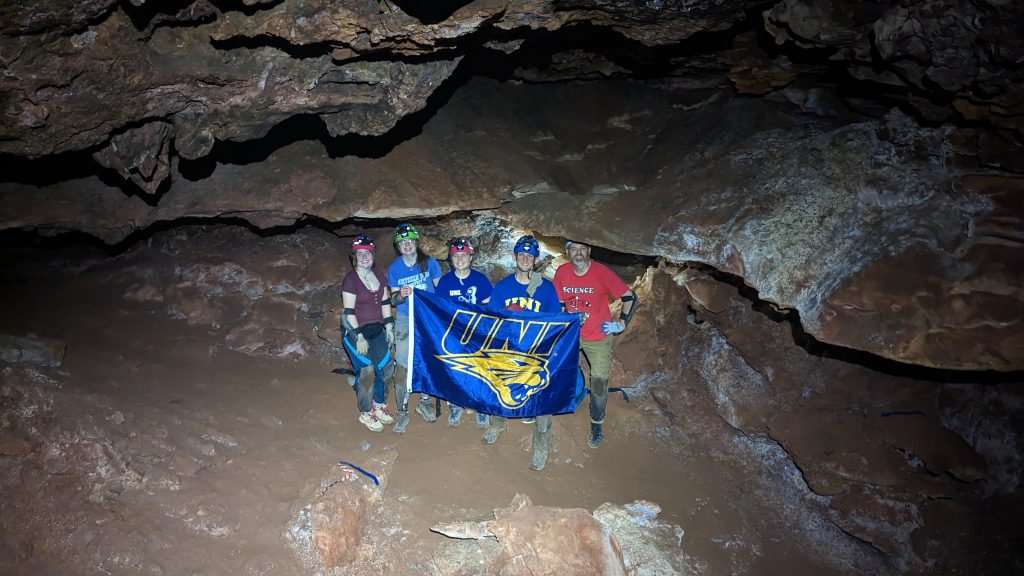I Spy A Zebra (Calcite): July 8-13
The University of Northern Iowa astrobiology team and Iowa Grotto members spent 18.5 hours underground at Wind Cave National Park over the span of 4 days in July. Led by Dr. Joshua Sebree with help from Marc Ohms, the group’s main objectives were to revisit the tour route science stations, collect microbiology and seasonal water samples, and perform science work in deeper areas of the cave to expand a list of planetary analog sites.
Sunday, July 9: After a week off of caving, a small team returned to Wind Cave National Park to follow up on science targets identified during the end of June trip. Public tours at the cave were halted because the elevator was getting repaired. The science team took advantage of the opportunity to follow up on tour route science. First stop of the day was to place a water cubie at Buffalo Gap. The team worked their way back and stopped at Silent Lake to test a new waterproof head attachment for a UV-VIS spectrometer. Using a longwave-UV light, the team collected spectra of the flowstone, rhine, and water. On the way back to the natural entrance, the group stopped in the Assembly Room and Giant Stone Quarry to characterize a red fluorescent film on the walls. The final stop before the trek up the stairs was a young flowstone that was beginning to form on a support beam. The team marched up the 240 stairs to the surface.

Monday, July 10: The team revisited the wild cave tour route to determine if a leak was still present from 2 weeks previous. On the walk down they found dog poop that had a thin layer of white mold. Dr. Sebree documented the scat, then made a note to clean it up on the way up. The group crawled for five minutes to get to a dome that was now dripping water where a waterfall had previously been. Water samples were collected to inspect for chlorine. While at the water sight, UV lights highlighted a red fluorescent film on the other side of the site. Under a white light, the film blended in with the neighboring moonmilk. Spectra was collected with longwave-UV light and a small scraping of the 1 mm red biofilm was taken. The team then went to the Assembly Room to compare the newly found biofilm to the red film analyzed the day prior. The team collected spectra of orange spray paint, red film, and the moonmilk. While documenting the biofilm, Dr. Sebree spotted a zebra calcite directly above the spray paint. Hopeful to find more zebras, the team split up and looked for clues. More biofilm and zebra calcite remnants were documented. On the way to the surface dog waste was cleaned up and disposed of on the surface.
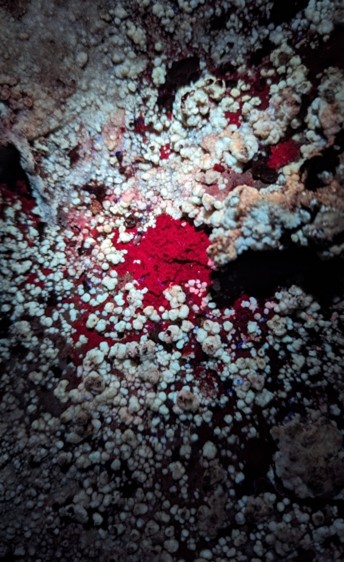
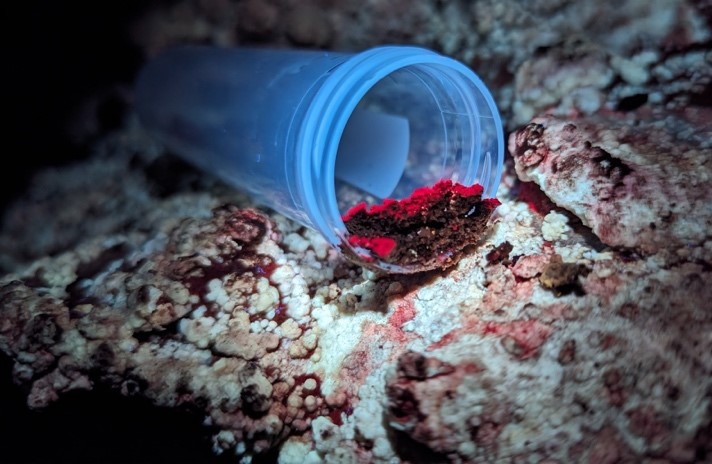


That afternoon, the group met up with Marc Ohms to visit Guide’s Discovery. Just off of the staircase, the team took a short crawl to their first “I (hope to) spy a zebra calcite” spot. Vugs surrounded a dry waterfall dome. Longwave-UV light illuminated a hot red and purple stripe zebra calcite. The formation was documented with longwave-UV photography and analyzed with a spectrometer. A chirt slide into a short crawl took the team to Guide’s Discovery. The group broke up into different sections of the room filled with breakdown. After looking for a few minutes, a new zebra was located and added to the catalog. Research student Jacque Heggen tucked into a notch in the breakdown to collect spectra of the purple and yellow zebra calcite. Possible leads downside passages were also looked at with little luck. The group then returned to the staircase.


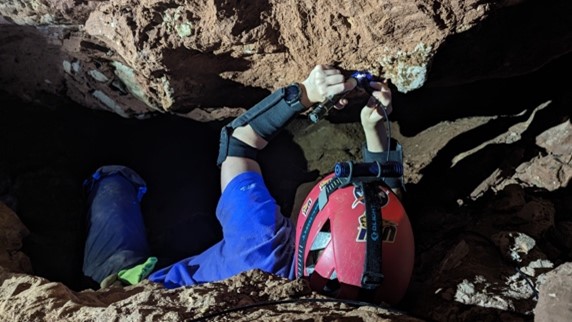
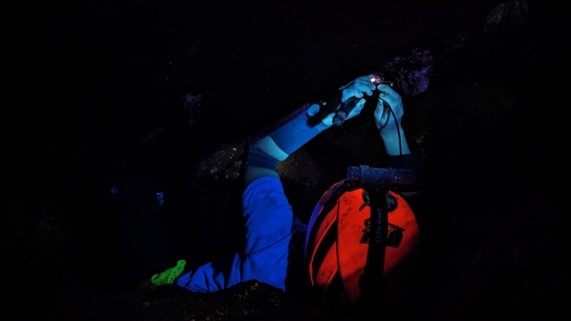
Tuesday, July 11: Equipped with a fishing line and lure weights, the team set off to Christmas Tree Park. At Buffalo Gap, the group reset the water cubie that had fallen over spilling a part of the container. At Yukon Trail, Zach Harper found a whale tail shaped zebra calcite between two layers of chirt. A calcite stripe lined the top of the ceiling. The zebra was documented with longwave-UV photography then the team continued to Christmas Tree Park. The aragonite Christmas trees are famous for their hollow centers, but the depth of the hole has never been measured. A 5-inch Christmas tree that was half broken was the first target. Using a neon yellow string, Dr. Sebree carefully lowered the fishing line down the nickel-sized opening of the Christmas tree. Down and down the line went until finally the weight could go no lower. Pulling out the string, the 5-inch Christmas tree had a 6 foot hole hidden underneath the delicate aragonite. Looking at the pea-sized weight was covered in chirt. A second 4-inch Christmas tree’s hollow center measured 4 feet deep.

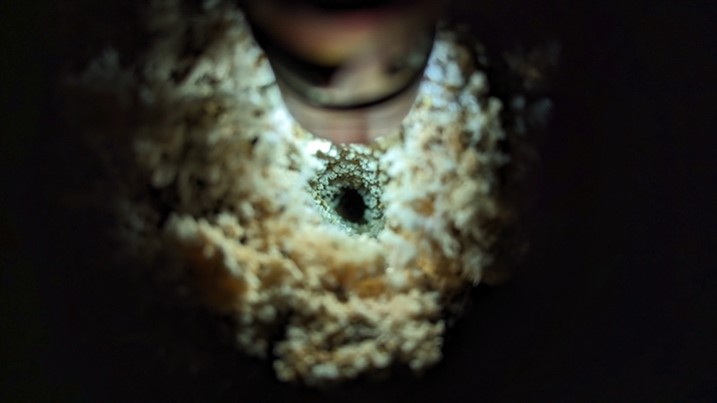

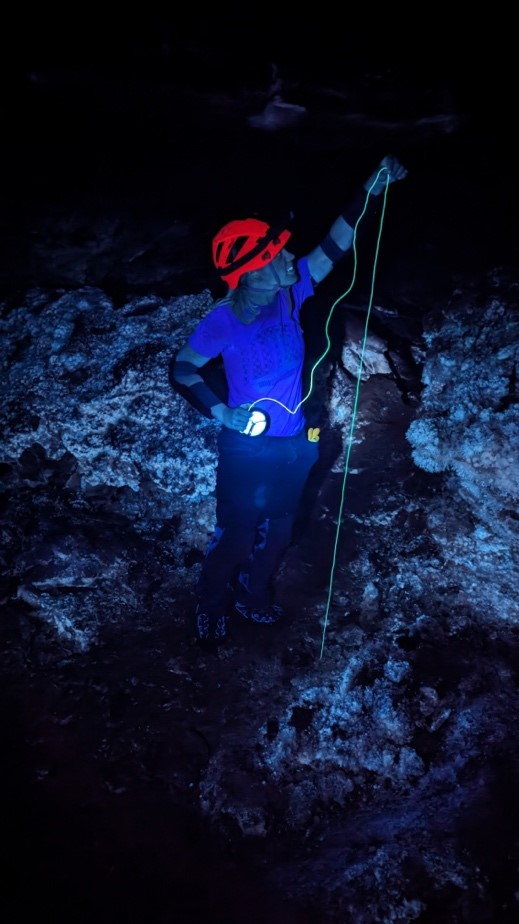

Wednesday, July 12: On the final caving day of the trip, the team walked to the visitor center to meet up with Marc Ohms at 8:15 am. The 4 person team walked down the natural entrance and set off to Roadblock Passage and the yellow trail. Crawl, climb down, squeeze, climb up, repeat. The descent down the first chimney narrows to a horizontal 8-inch squeeze. Stemming across 2 flat walls, the team worked their way down straight. There was a flat walkway into an upward vertical boxwork staircase. Climbing over large pieces of chirt breakdown, the team pushed on. Stemming up a boxwork chimney the group arrived at the Multipurpose Room.
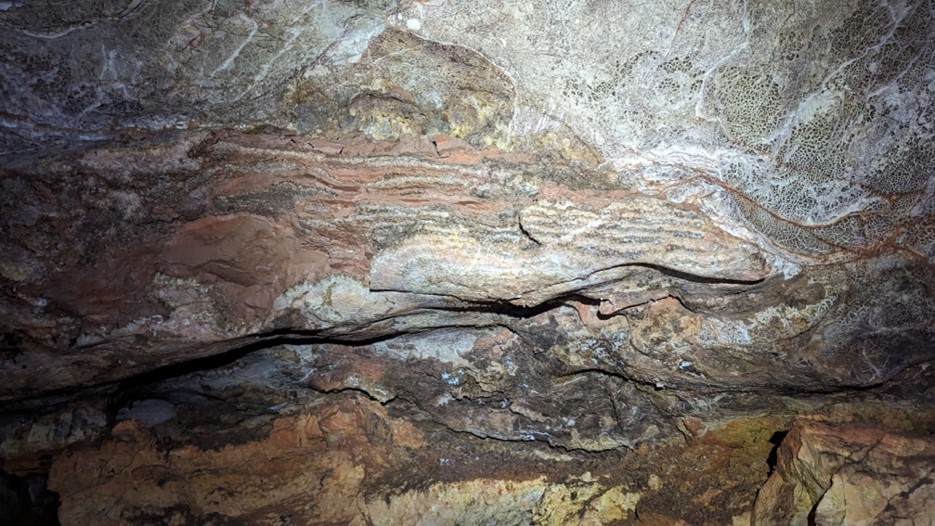
At the turnoff, a fallen zebra calcite was spotted on a large piece of breakdown. The team made a note of the zebra and continued to ensure they could hit the final destination. Climbing past, with one hand wrapped around a yellow tether and the other gripping the wall, the team rope climbed up a wall next to a flowstone to get to Coke Room. From the natural entrance, it took 1.5 hours to get to the Coke Room. The team stopped for a short snack break and photo op then continued on their way into a series of crawls. Unskinny Bop offered a new space to practice yoga moves. The upward chimney started with an 8-inch squeeze where the team had to enter on their sides then pull through to an immediate 90-degree climb. Wedging forearms on ledges, the team got to the top of the chimney one at a time. The opening at the top was another perpendicular squeeze. Climbing in between the transitional layers of the cave, many more zebra calcites were found on the route. After a slight crawl, the science team collected water samples at a cistern. Moving forward, the walls were covered with zebra calcite remnants. Crawling on hands and knees the group made it to the pinch point. After teeter-tottering through the squeeze, the team made their final crawl to finally made it to Archimedes Pool. Zebra calcite surrounded the opening around Archimedes Pool. The science team crawled around the middle pit to get to the outskirts of Archimedes pool. A thin layer of chirt dust covered the lower part of the bowl and edges. When UV light was shone on the chirt surface, the underlying zebra bowl became visible. Up close, the zebra calcite around the pool shone purple and blue. The pool had no rhine around the edges but a zebra calcite just above the lake. Microbiology samples were collected in and around the pool’s surface. The pool was documented with longwave-UV light photography. Spectra were collected with the spectrometer for the blue and dull purple zebra calcite.
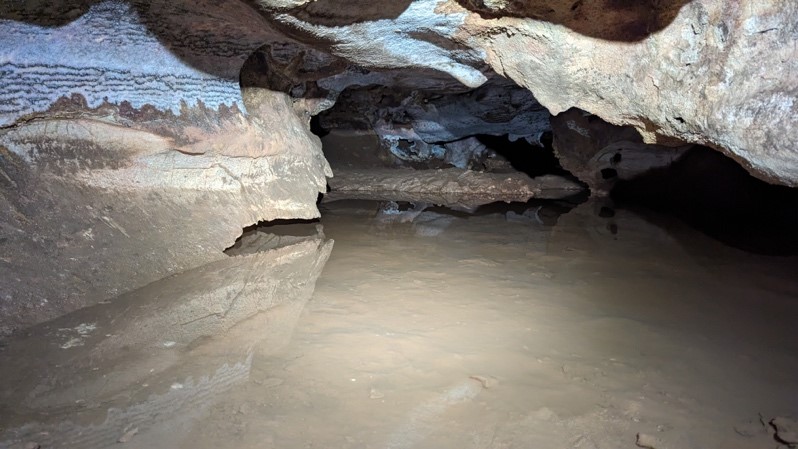
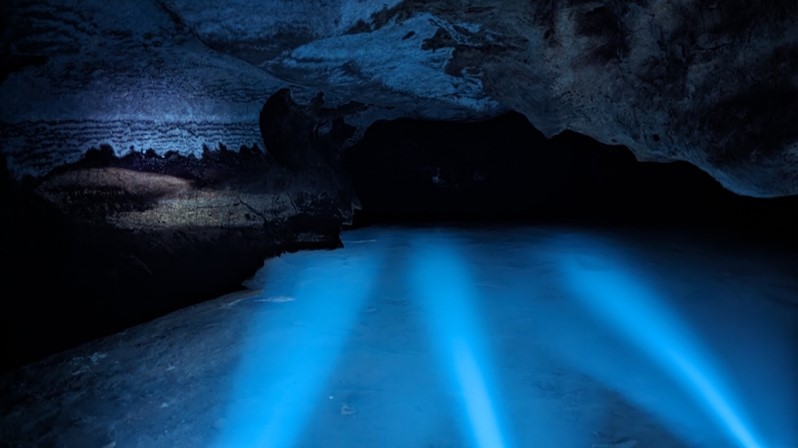
The team then traveled back through the climbs and crawls to get back to the surface. The group surprised surface watch spending 6 hours and 20 minutes underground for the allotted 8.5 hour trip. With the discovery of the zebra calcite bowl at Archimedes Pool and the consistent pace of the team, the highly anticipated expedition to Archimedes was a big success.
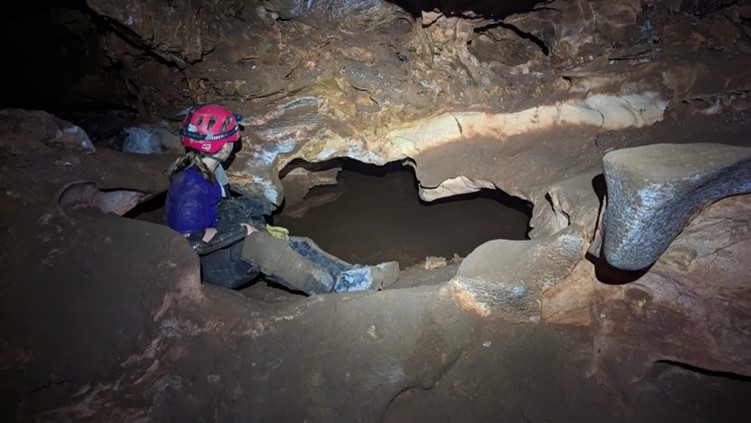

Quest to Find More Calcite Speleothems: June 19-30
The Astrobiology Team spent 12 days working on Cave science at Wind Cave National Park on a follow-up mission to the May trip. With help from Mark Ohms, Dr. Sebree and a team of undergrads performed science in new parts of the cave. The primary goals of the trip were to: 1. Collect previously deployed Petri dishes, 2. Match Zebra Calcites with depth, 3. Collect Microbiology samples, 4. Perform the first in-depth analysis of unique calcite features in the north-west of the cave, and 5. Begin a human cognition study of the cavers. Additionally, two media students documented the trip for a mini docu-series.
Tuesday, June 20: The team started off the day with cognitive testing led by UNI Department of Kinesiology and Athletic Training professor Dr. Mark Hecimovich and students. The underground team completed reaction tests before heading to the elevator. Chemistry researcher Jacqueline Heggen placed collection cubies underneath a flowstone in Buffalo Gap. Venturing through familiar squeezes like Hobson’s Choice, the group spent time stretching out and finding their cave legs to prepare for the intense caving to come in the following days. Undergraduate research student Abbie Bangs collected microbiology plates deployed on the May trip in North Club Room. The team went to Christmas Tree Park and admired the foot-tall Christmas trees and documented flowstone along the wall before Roadblock Passage. After their trip, the team completed a post-caving cognition test while their brain was monitored.
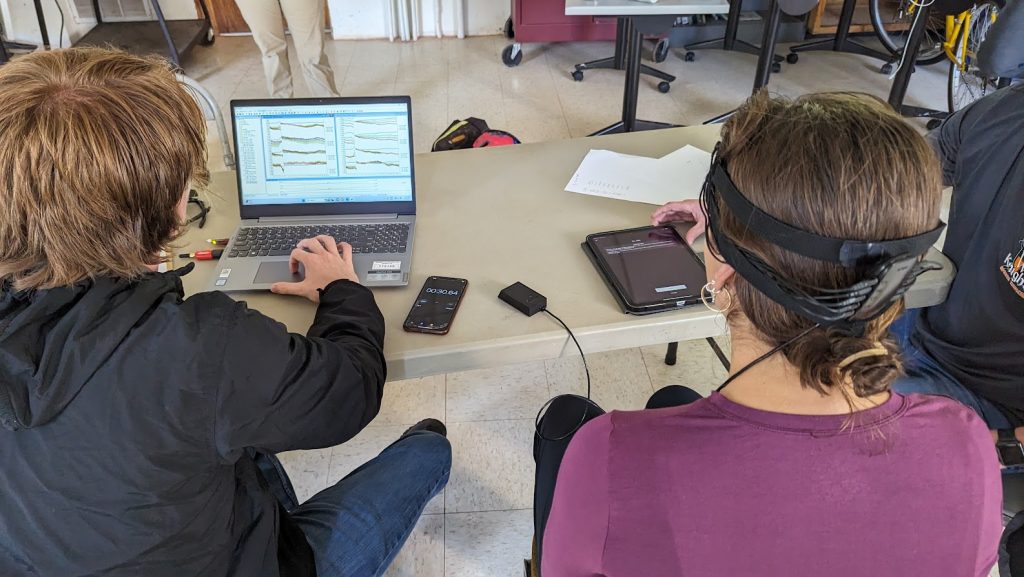
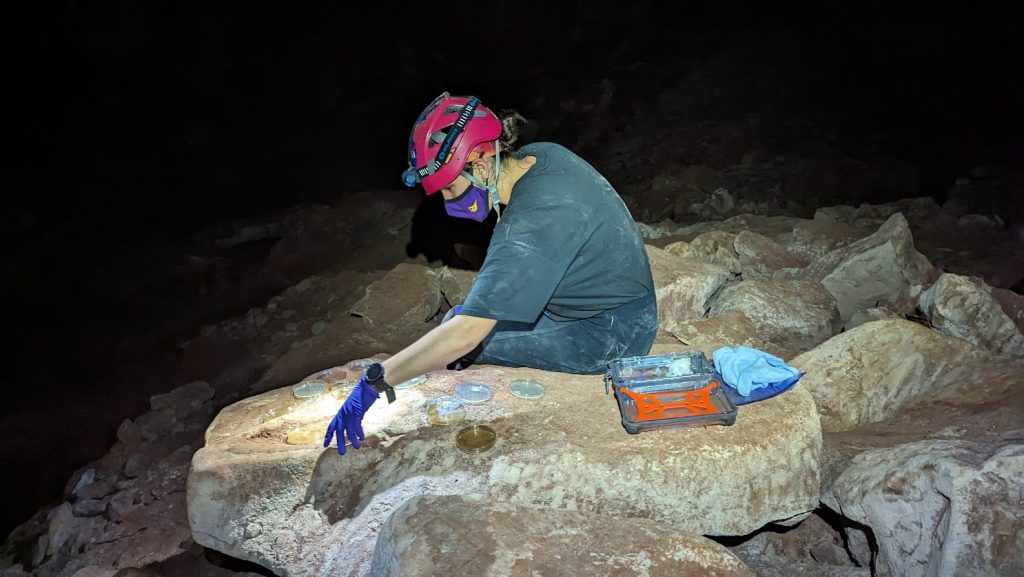

Wednesday, June 21: Thunder and lightning gave the team a midnight wakeup calls early on day 2. The team sprang out from their tents and went to VIP (Volunteer in Park) Center for protection from the lightning storm. Just as the group was ready to go to bed, water flowed in from underneath the door. The team started squeegeeing water out of the building while others picked up science equipment away from the flooded area. After an hour of re-barricading the door, the rain finally stopped allowing the team to get back to sleep. Hours later the team embarked on the longest one-way trip possible in Wind Cave, which happened to also be on the Summer Solstice (the longest day of the year).
After the pre-caving cognitive tests, the group walked up through grass to the Snake Pit entrance, the highest point in Wind Cave. Down the pit, the path was tight but clear. The vertical drop transitioned into a flat 9-inch squeeze. Inch-worming along the path, the team worked their way through the 500 feet of pinches and slides for 1.5 hours. Eventually, the small squeeze opened up into a large breakdown room. The team rope climbed down walls and over breakdown to get to the first science stop. Covered with moon-milk and 2-foot-tall Christmas trees, Santa’s Frosted Forest lived up to its name. The science stop lasted less than 5 minutes to document the formations within the room in white light and shortwave- and longwave-UV. Passing from Santa’s Frosted Forest, a smaller room (about 4 ft wide) was circumscribed with Zebra Calcites. With their sights on another benchmark, the team pushed forward.

The primary science target was located adjacent to the Chimera Room. The hollow calcite speleothem looked similar to a Christmas tree but fluoresced green under shortwave UV light. After closer inspection, it was found that the hole within the speleothem extended through the rock it and was visible under the ledge the formation was sitting on. Shining a white light through the hollow center resulted with the candlestick lighting up in a rainbow effect. This discovery left the group asking more questions than they started with. The team needed to keep moving to keep on pace, so the additional analysis was put on hold for a future trip with a different science package.
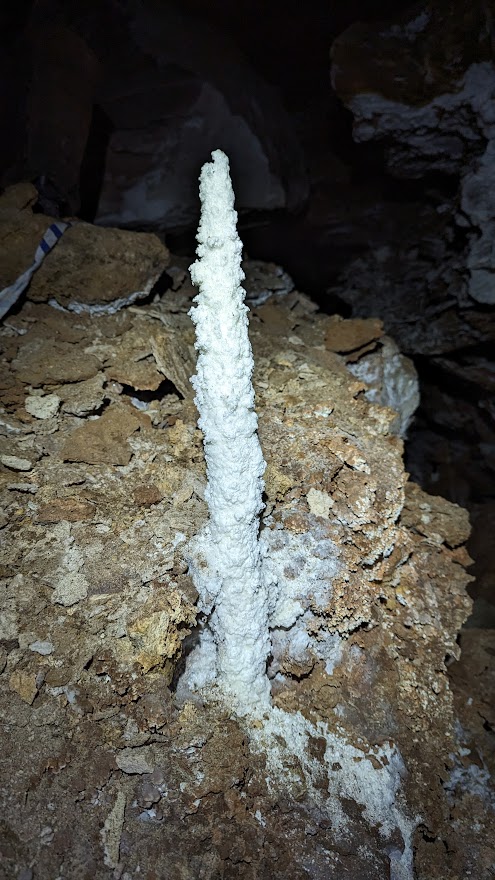
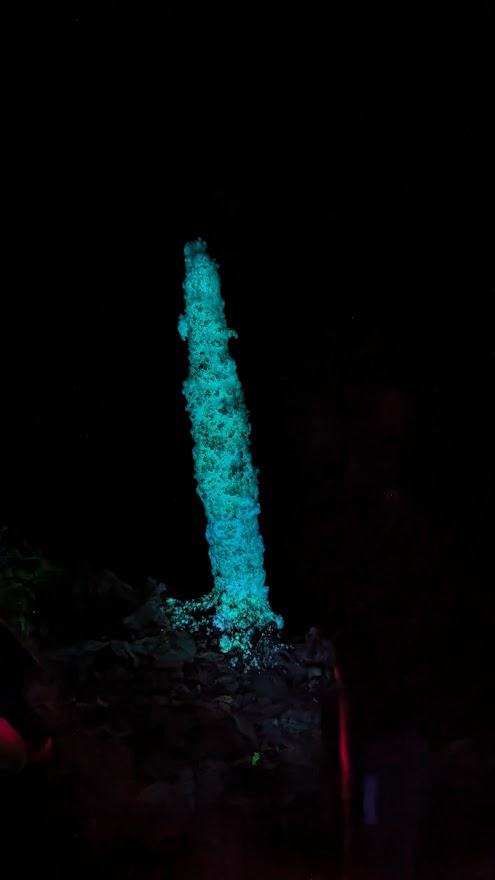
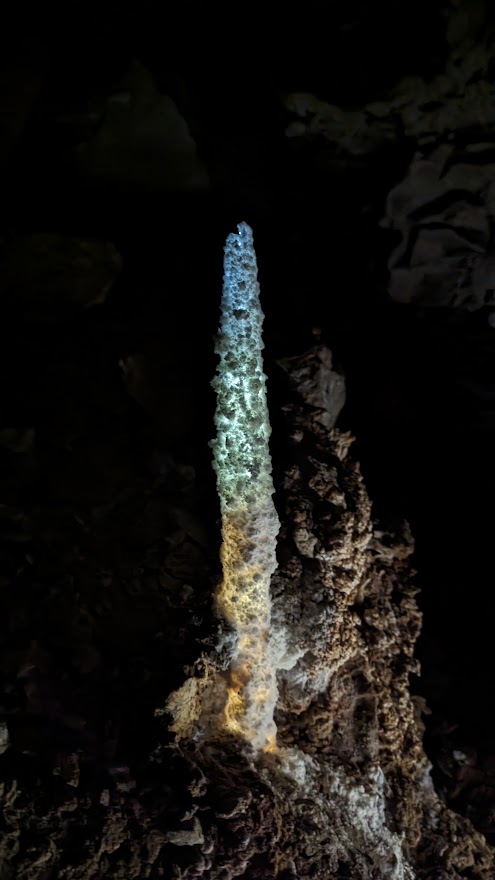
The next room, Chimera Room, opened into a huge break down section which extended for several hundred feet. The team traversed over steep climbs to get to the bottom of a wall. New Zebra Calcites were identified to be added to the Wind Cave inventory.
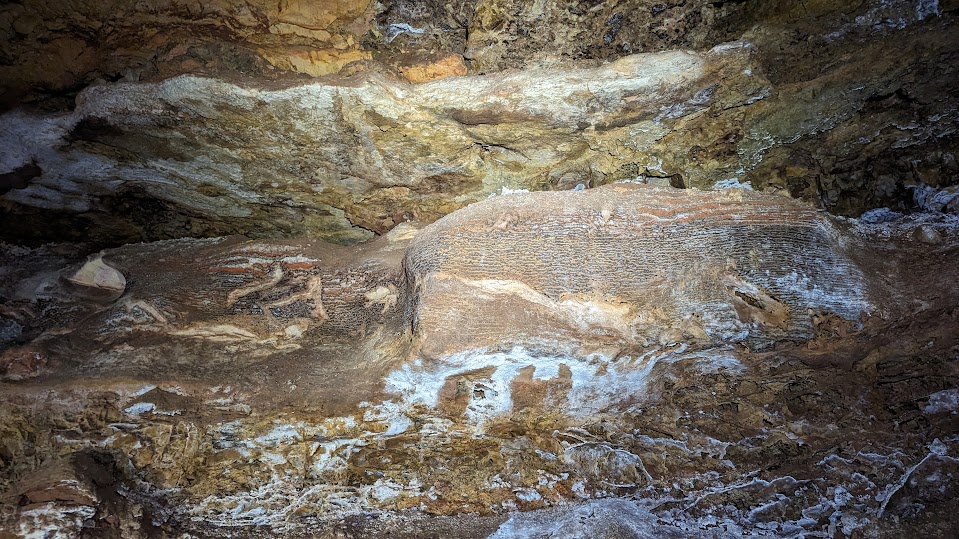
Biochemistry Student Abbie Bangs retrieved additional microbiology plates deployed during the May trip. Stemming over the crevasse, Bangs collected the samples and packed the kit in her bag. The team made their way picking up additional plates in a crossroads junction and near a flowstone close to South Club Room. The team glided through familiar territory back to the elevator. After 7 hours underground, they walked to the elevator to discover it was down for repairs. Now the hardest part of the trip, 200+ stairs to the surface via the natural entrance. With 7.5 hours underground, the Snake Pit Entrance to Natural Entrance expedition was a success. Figure 6: Snake Pit team post-7.5 hours in the cave.
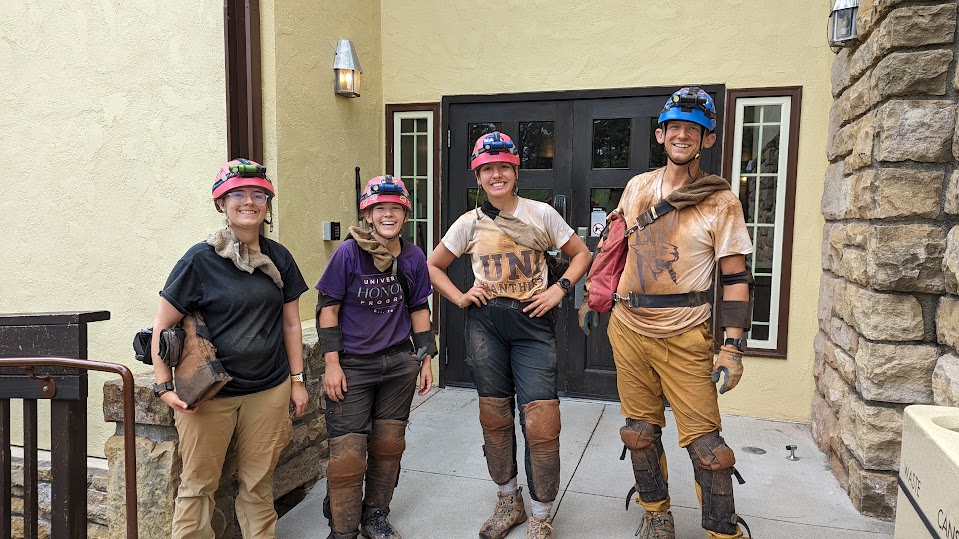
Thursday, June 22: Day 3 was a relaxed start for the team. The group took a 3rd set of pre-caving brain scans and went underground to investigate a possible groundwater pipe leak infiltrating the cave. Along the wild cave tour route, a waterfall had flooded the area and smelled faintly of chlorine. Water and microbiology samples were collected from the waterfall and surrounding pool. The group then revisited the fluorescent vug found during the May trip to capture the red phosphorescence using slow-motion filming.

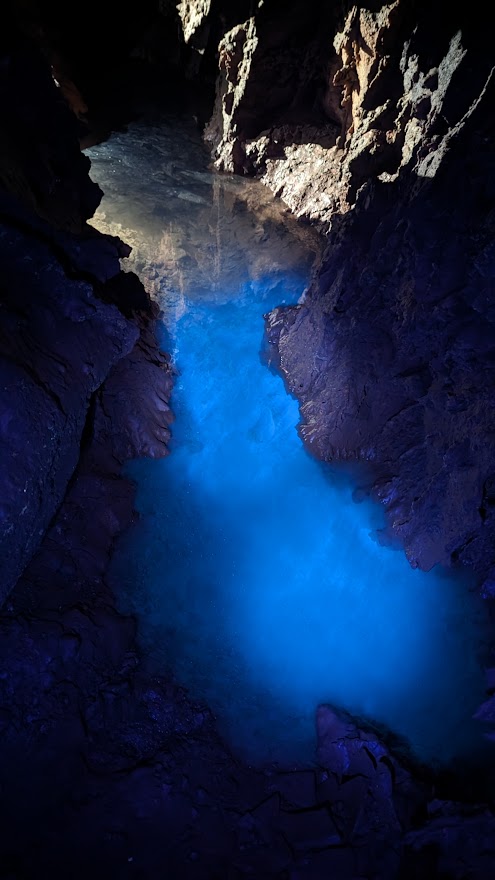
Friday, June 23: Starting from the assembly room, the team’s goal was to determine if the influx of water had filled Phantom Lake. Climbing down chimneys and crawling through pancake squeezes, the team found their target filled with peanut butter mud. The once-dry lake was filled with water that shone blue under UV light, indicating a substantial level of organic matter had been dissolved. A film of dirt sat on top of the water. As water and microbiology samples were gathered. Care was taken to prevent loss of shoes and equipment into the mire. The lake was clearly freshly (weeks old) filled. Plans to monitor the lake levels were made for future work.
Saturday, June 24: Day 5 led the group back to Club Room. Heggen led the group to the North Club Room as part of emergency preparation training. Just past the midpoint of Club Room, the team relocated a Zebra Calcite along the west wall of the room and discovered a mirror image Zebra Calcite on the east wall. At the south end of the Club Room, the science team used longwave UV light to carefully study the flowstone on the ground and collect UV spectra of different thicknesses of the formation. The flowstone had sections that shone blue and green. The team then returned to the Zebra Calcites in the middle of the hall. The mirrored Zebra Calcites (one on each side of the room) spanned over 10 feet across the walls Under UV, the Zebra shone hot pink. The team documented and recorded the UV spectra of the Zebra Calcites. On the way back, spectra were collected for a dark yellow flowstone near Roadblock.
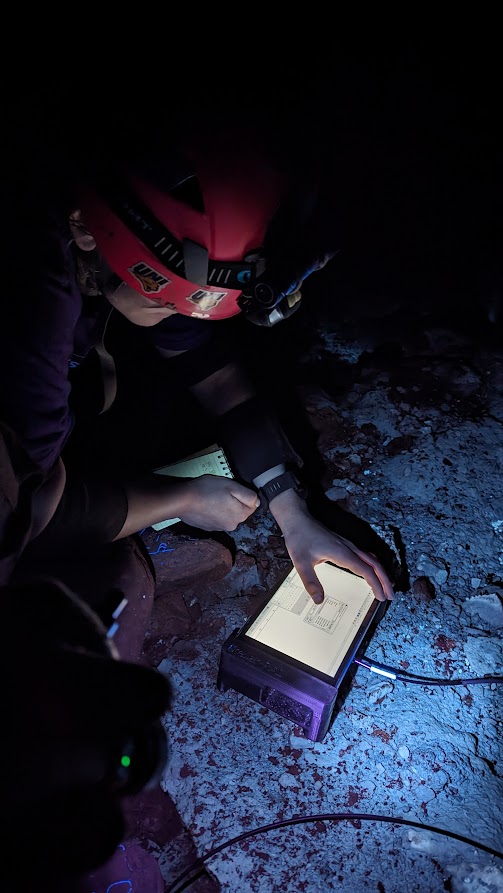
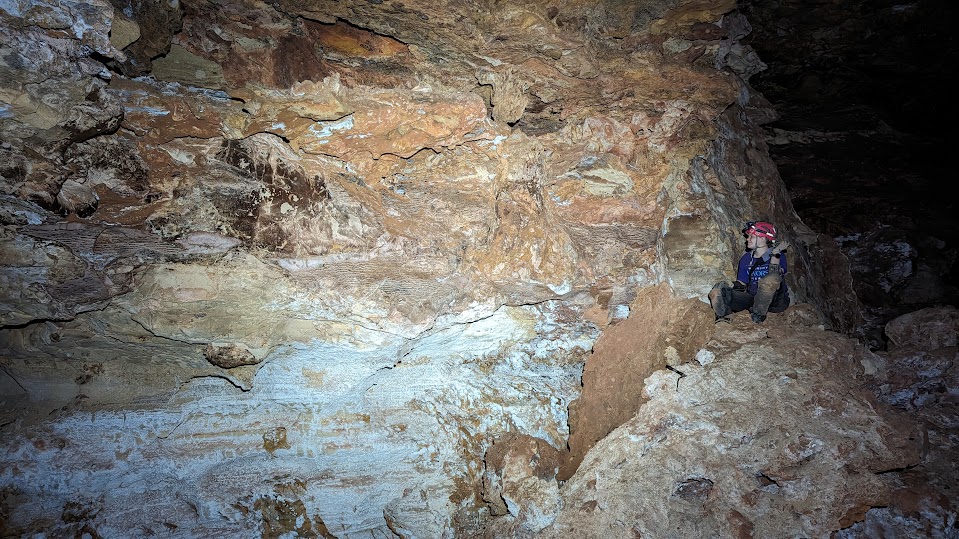
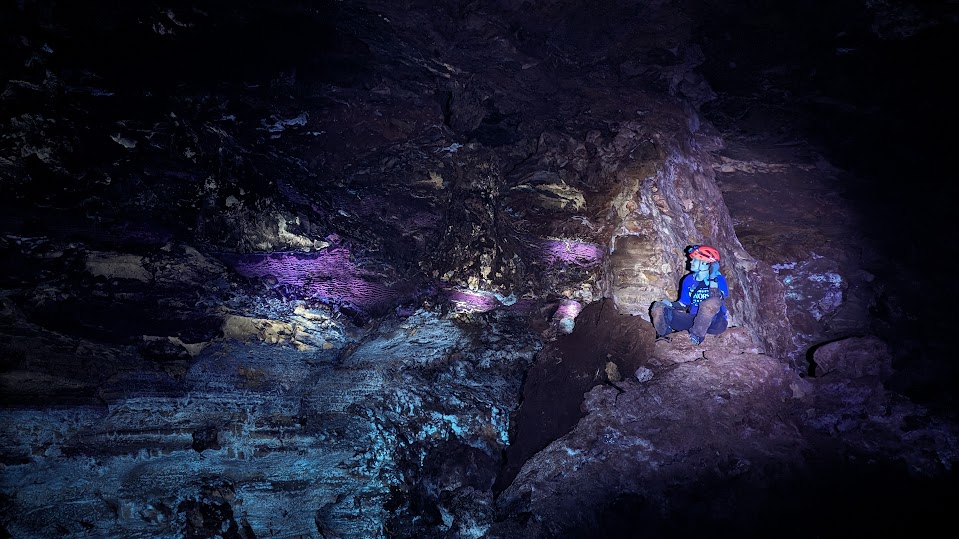
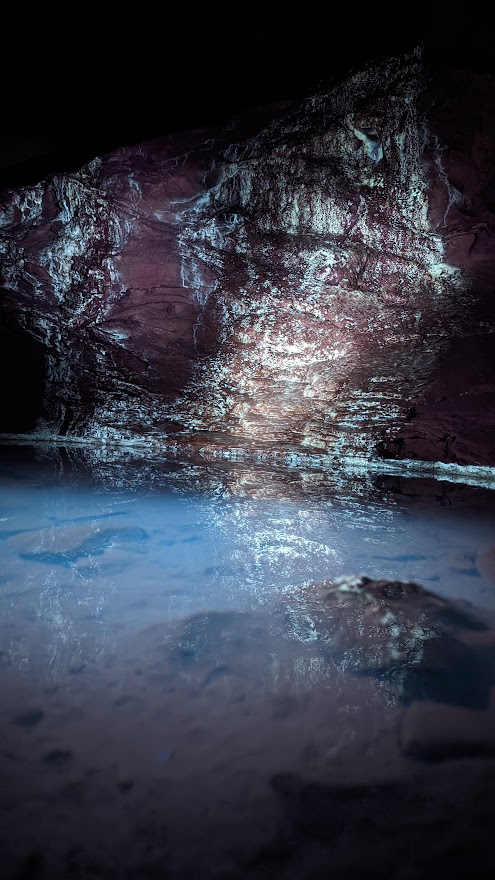
Sunday, June 25: The group went to Silent Lake to collect water samples and spectra of multiple flowstones in the area. The flowstone and the border of the lake both glowed under longwave-UV light. The team also collected spectra of a dry flowstone just past Silent Lake. The final science objective for the day was zebra calcite hunting in the area. The known Zebra Calcite in the area shone dark purple under UV light and was located between two layers of chert. The team traced the chert in the surrounding rooms to try and find remnants of other zebras. No additional Zebra Calcites were located in the region.
Monday, June 26: The team practiced survey skills with a disto in the VIP Center with a goal of measuring the length of the Zebra Calcites at Club Room the following day and tying the find into the Wind Cave survey. In the cave that afternoon, the team visited the Zebra Calcite dome-Serengeti. Crawling past a water drip that smelled faintly of chlorine, the team collected water samples along the Wild Tour Route. The Zebra Calcite dome has an active flowstone and a ceiling filled with Zebra striations. The dome stretches back 15 feet and fluoresced purple and pink. The part of the dome the was covered with flowstone had muted the vibrant colors of the outer Zebra and fluoresced blue. Team collected spectra of the bands with a spectrometer. Lining up the disto on a survey marker, the team measured the Zebra ceiling. One side passage ceiling was 16 ft while a side passage off the entrance was 13 feet.
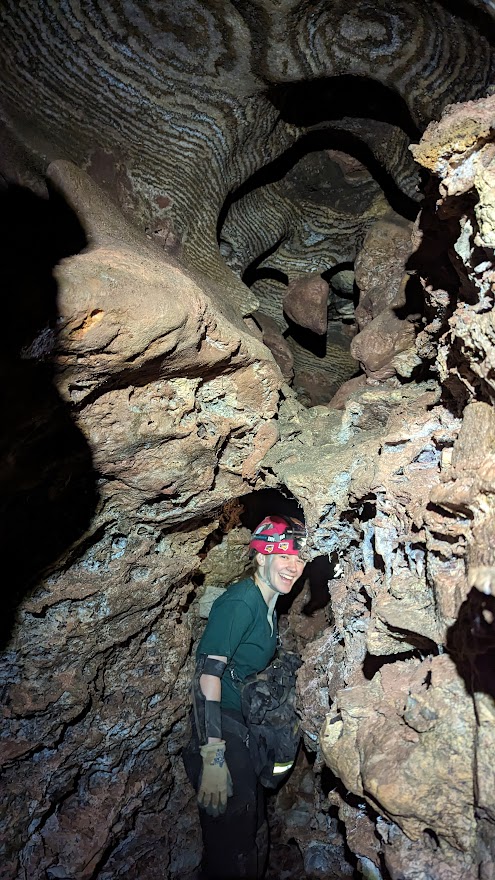
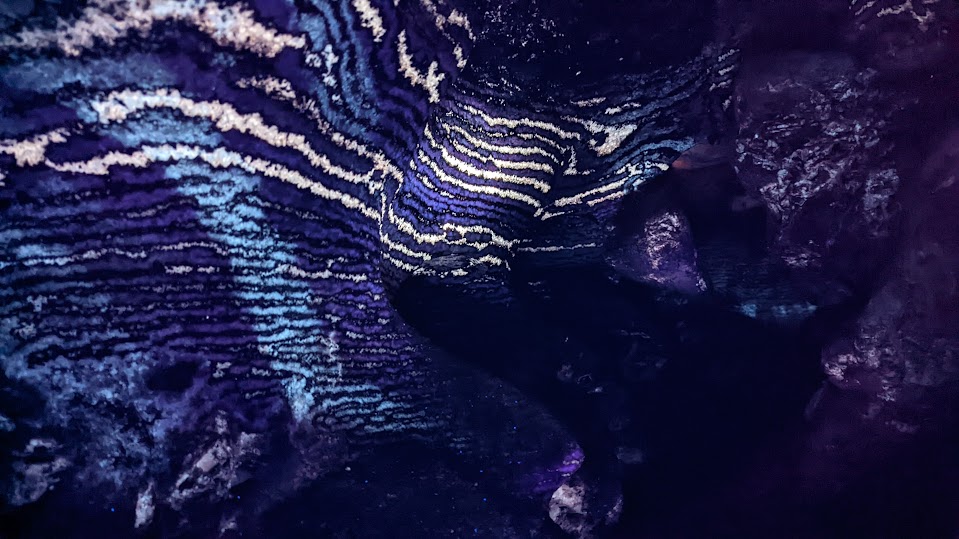
Tuesday, June 27: Heggen continued to learn to lead the group to Club Room. Returning to the Zebra Calcite bands, the team got to the science stop with plenty of time to perform all their science. The team first documented the Zebra with additional UV pictures. The science team used an upright rock and spotted the distance from the survey markers. The team measured both mirrored Zebras with the disto to eventually be added to the map of the room. On the way back to the surface, the team set up a water and food cache for the next day’s deep trip.

Wednesday, June 28: Day 9 was filled with many highs and lows for the team (in the literal sense). The team traversed up and down 4 climbing walls of chert and boxwork. Traveling through the top and middle layers of Wind Cave, the group climbed by popcorn, scaled walls full of boxwork, and traveled over chert breakdown. The team shimmied past vertical walls.
As the 6-person team inch-wormed through the cave (bunching up and stretching out) on the steep climbs, the slower pace down both allowed for science along the way, but limited the depth of the initial foray into this region of the cave. At Coke Room, it was determined that there wouldn’t be enough time to perform all the science that the group wanted to accomplish. After an early lunch, a pristine flowstone, just past Coke Room, was determined to be the turnaround point. The science team collected spectra on this feature before beginning the series of climbs home. On the return, the group spotted a new Zebra Calcite along the wall of a climb was documented. The Zebra shone bright pink with blue stripes, adding a new fluorescent color (blue) to the Zebra Calcite list.

Thursday, June 29: The trip reflected on their 10 days underground with interviews for the media team. In total, the science team spent roughly 34 hours underground.
Friday, June 30: The Astrobiology team broke camp and returned to Iowa for a well-earned 4-day holiday weekend before their next trip.
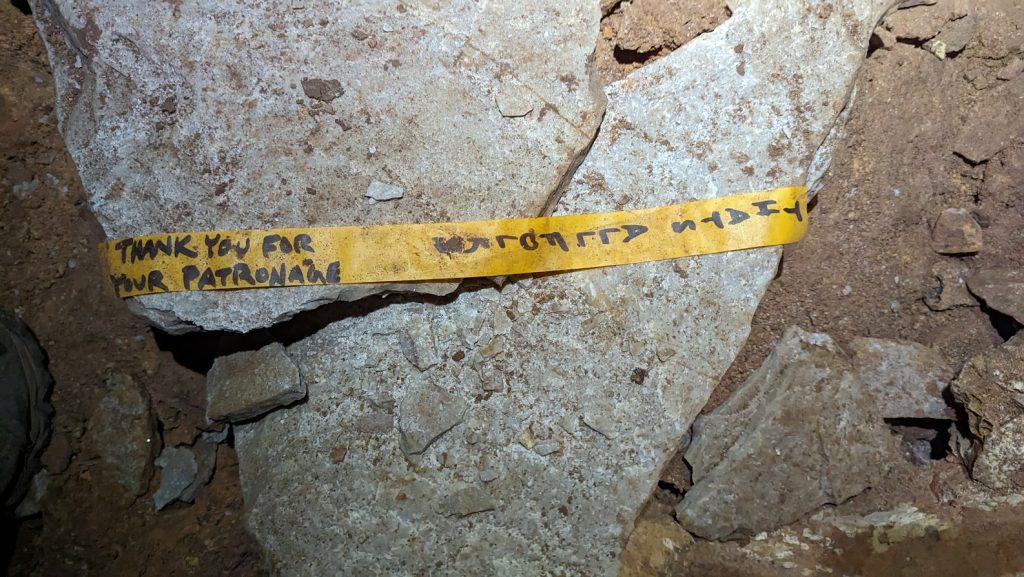
Zebra Calcite Hunting in Wind Cave: May 21-27
At the end of May, the Astrobiology Underground team from the University of Northern Iowa spent 5 days performing cave science at Wind Cave National Park. Dr. Joshua Sebree and a team of four undergrads worked on multiple projects underground with Marc Ohms. Goals for science exploration included testing hypotheses of Zebra Calcite locations, inventorying previously undocumented Zebra Calcites, and educating new research students on procedures. In addition, two digital media students were tasked with documenting the work for a series of mini-documentaries.
Monday, May 22: The goals for the first day were to teach new summer research students technical skills for gathering information with a spectrometer, break in new gear, and prepare for the long cave expedition later that week. The group started the day traveling past Silent Lake to Spillway. At Spillway, Dr. Sebree demonstrated how to use the portable spectrometer on a Zebra Calcite. Analyzing the bright purples and whites of the Zebra Calcite, research students gathered data and refined their skills. After collecting data, the group ventured to Omnibus Hall to familiarize themselves with the route for future explorations.
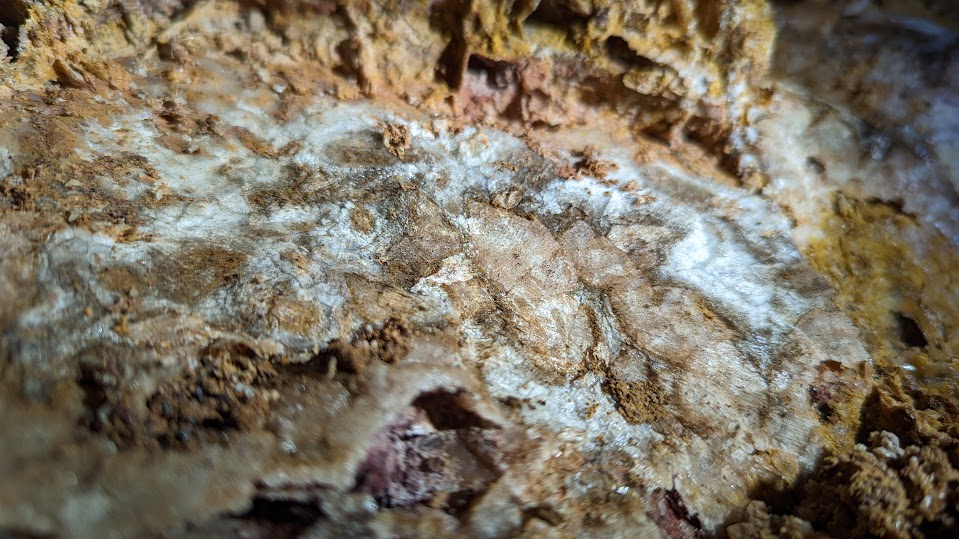

That afternoon, the team met up with Marc Ohms to analyze the Zebra Calcites in the Chamber of Lost Soles. There was a calcite vug that fluoresced bright purple and dim white under longwave-UV light. Under closer inspection, part of the vug shone bright white. After examining the vug with the spectrometer, it was inferred that the brighter material was an organic-rich calcite material from a secondary formation process.
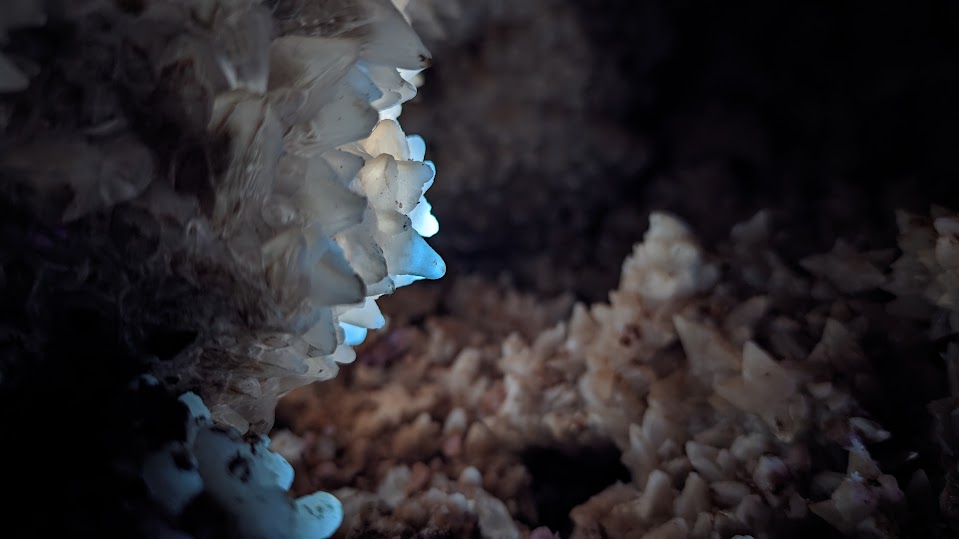
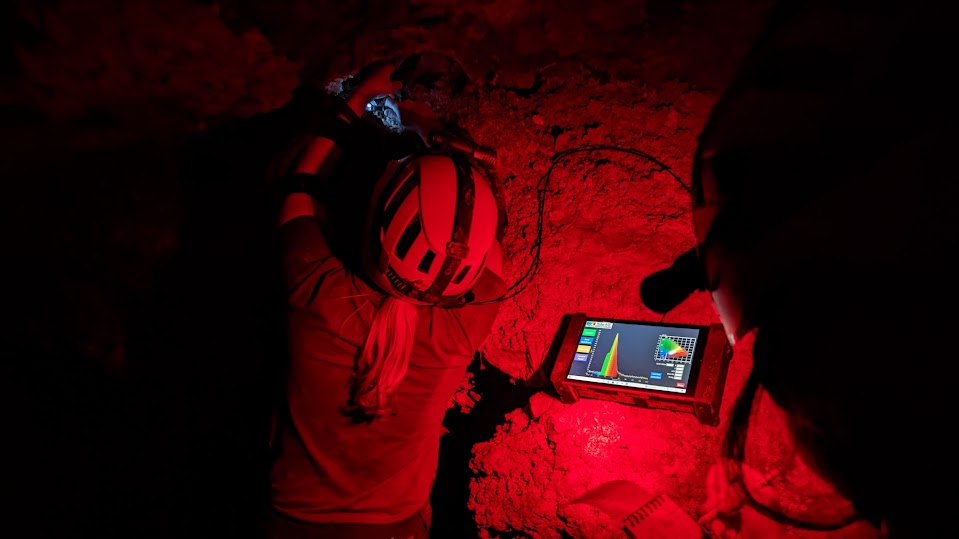
Tuesday, May 23: The team traveled past Omnibus Hall to Buffalo Gap. At Buffalo Gap, sterile water collection cubes were placed underneath a flowstone to collect drip water. The team squeezed through Hobson’s Choice behind Buffalo Gap and passed by Chinese Mushroom to enter the middle of the Club Room. The trip to Club Room took 2 hours with stops to allow the student media team to practice filming both science and caving. After collecting interviews for the media team, research students prepared to place Petri dishes. In the northern part of the Club Room, a bright white chimney suggested airflow. Using sterile gloves and a face mask, the Petri dishes were placed underneath the chimney where they would be collected during a future trip in June. The group then traveled back to the surface.
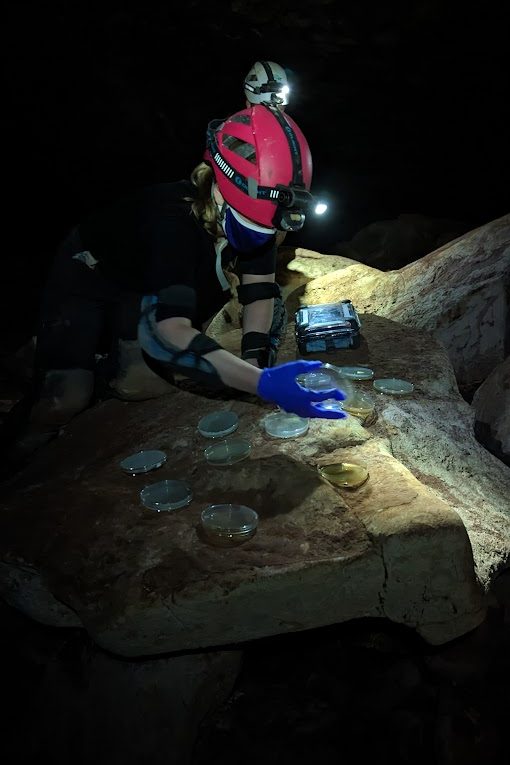

Wednesday, May 24: Day 3 was filled with Zebra Calcite hunting. The group stopped in rooms periodically to look for formations in between chert and boxwork layers. A multicolored Zebra Calcite was found not far from the beginning of the Natural Entrance tour. The Zebra Calcites were photographed using longwave-UV photography. Under closer inspection, the Zebra Calcite fluoresced bright white and purple (like others found previously) and also a dull yellow and bright red. The intensity of the Zebra calcites were analyzed with the spectrometer. Zebra Calcites were also found and documented in Room Daculum and at several transitional points in the area.
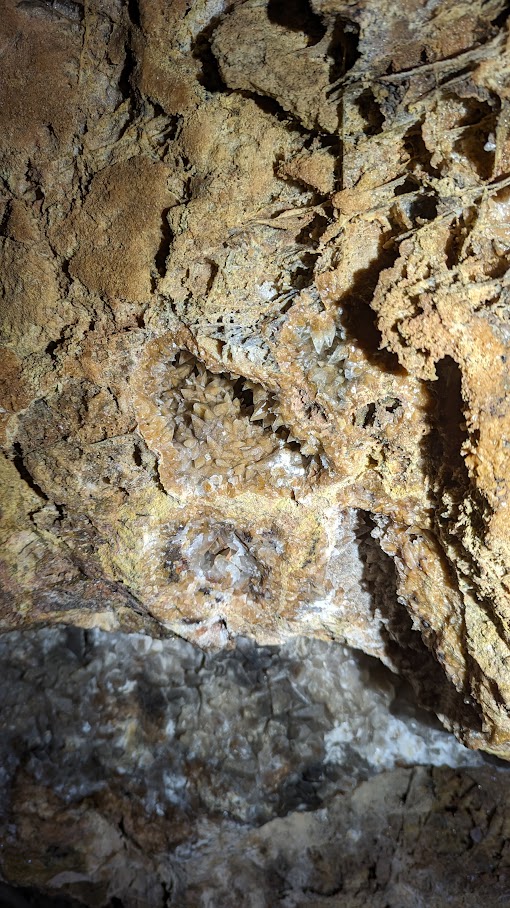
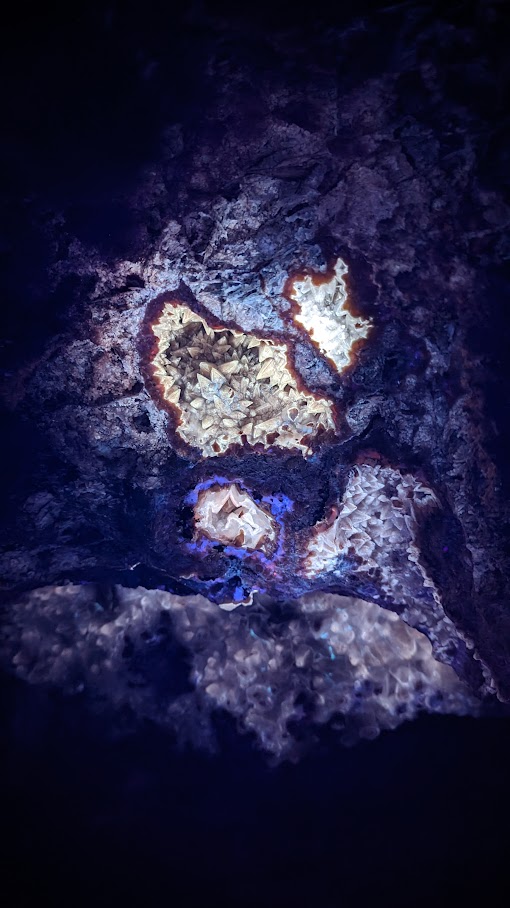
The afternoon was spent longwave-UV photographing a large Zebra Calcite found in a chamber above the Cathedral (near the end of the Natural Entrance Tour Route). With the naked eye, the chert above and below the zebra appears to be the same color. Under UV light, the upper and lower layers of the chert are two different shades (white and yellow).
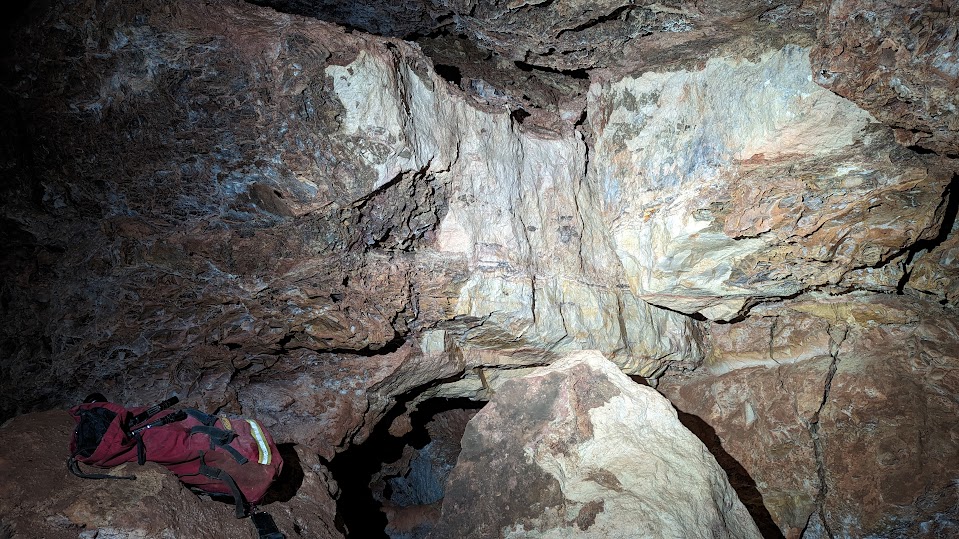
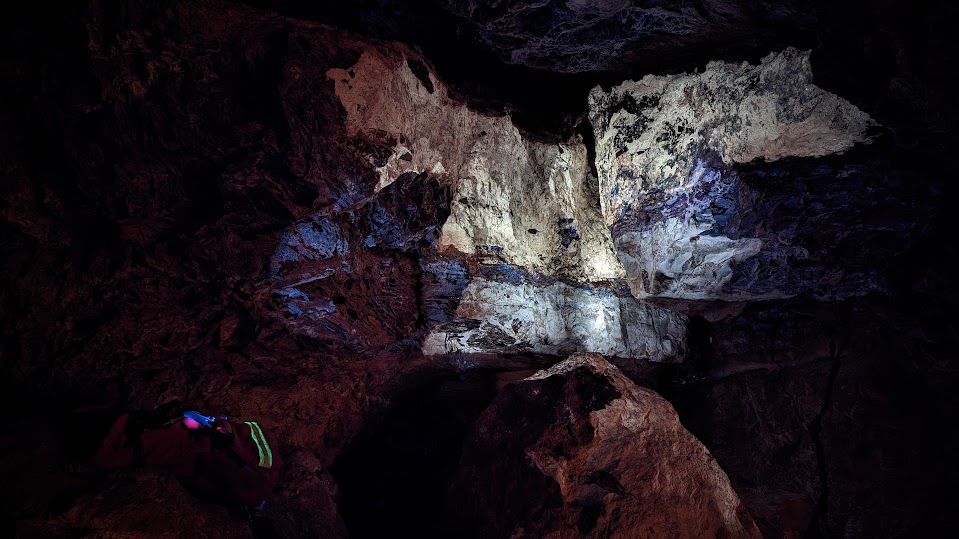
Thursday, May 25: The fourth day took the Astrobiology team farther than any UNI students had gone before. The team swiftly made it to Buffalo Gap in 25 minutes and to Club Room in under an hour. As the group passed through Club Room, a large Zebra Calcite was found on the wall. As the team moved deeper, they ventured into a side passage to deploy petri dishes along the only other route to a significant natural entrance. Above a large crevice, the petri dishes were sat on a ledge that funneled air from below.
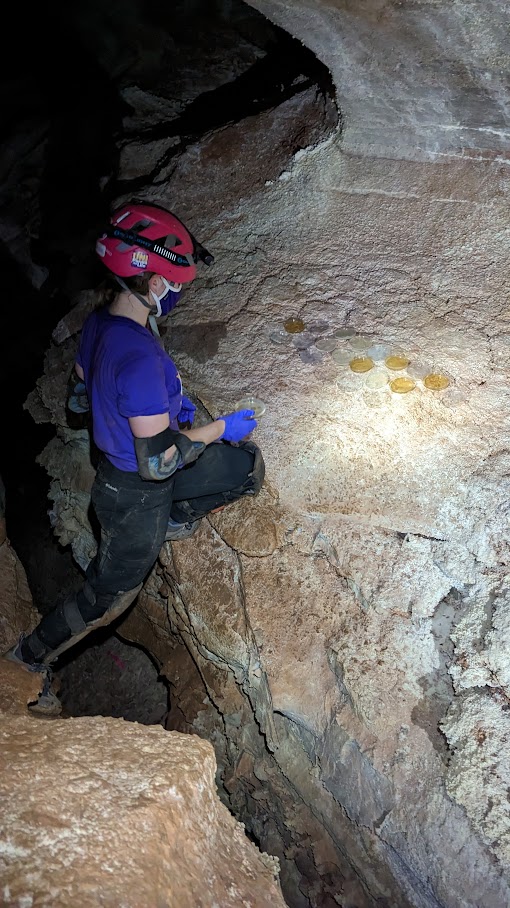
Trekking onward the team found other large undocumented Zebra Calcites in Half Mile Hall and other locations. The team maneuvered through tight crawls and steep climbs to finally arrive at the cistern to fill up with water, both to drink and to study. During the return, the new Zebra Calcites on the route were photographed with longwave-UV and documented. A final set of petri dishes was deployed along the way back in an area that collects water moisture on the ceiling. All told, the team spent 6 hours underground, 4.5 hours on the move, 1.5 hours of science on film.
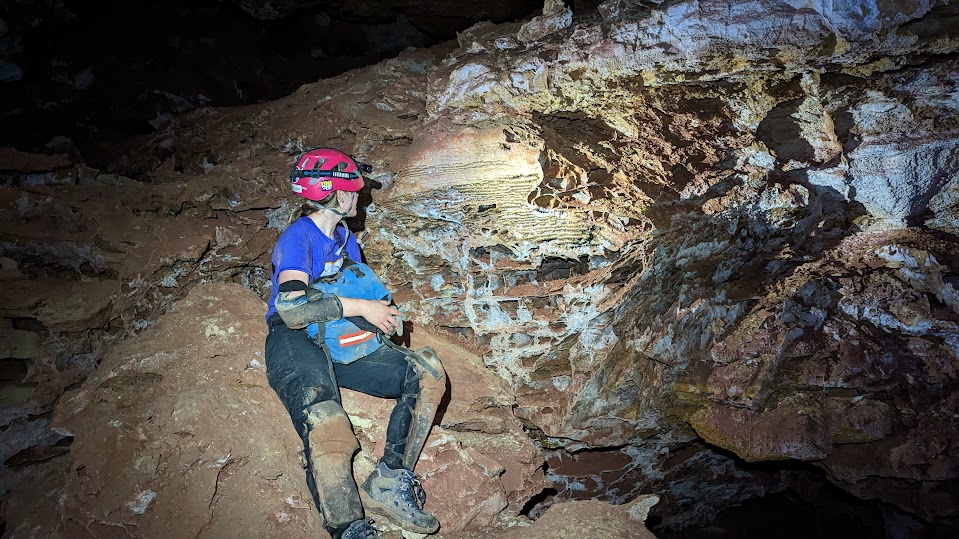
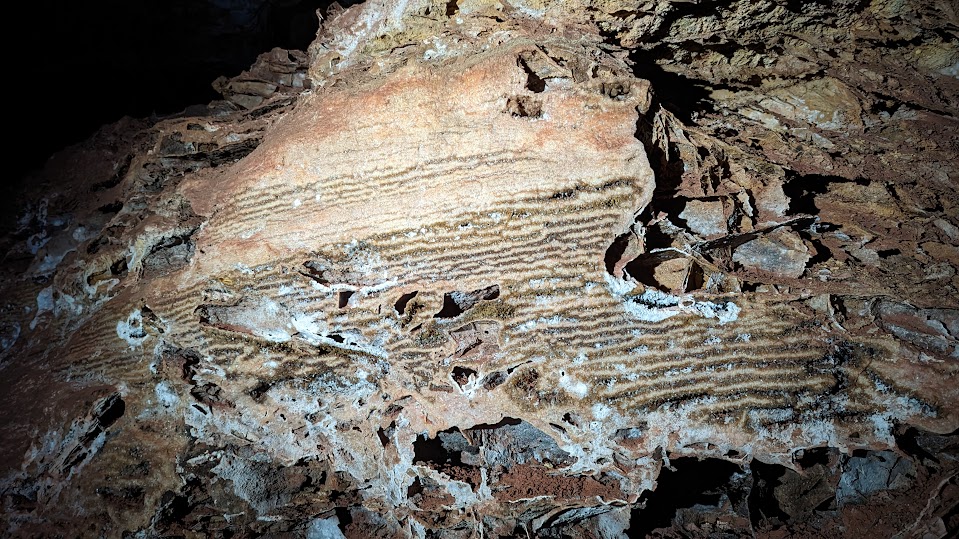
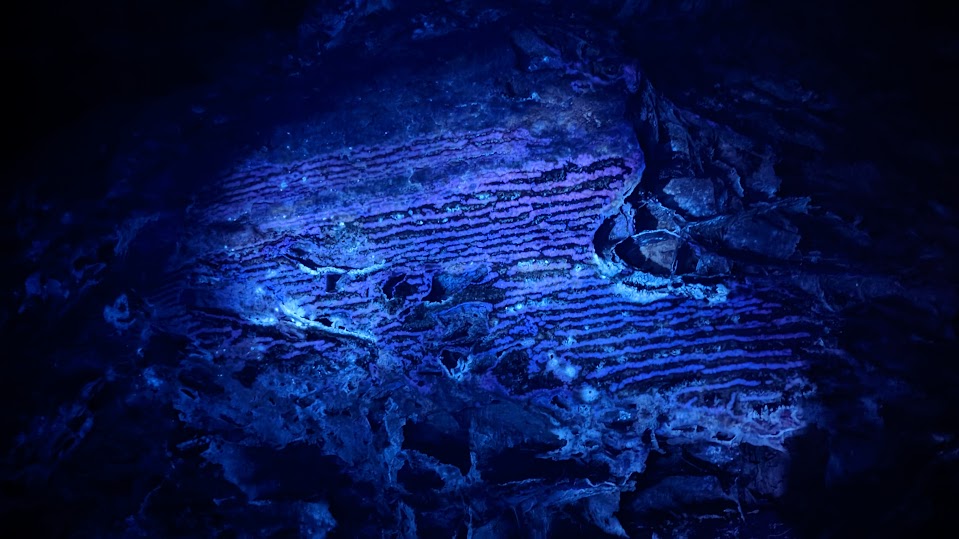
Friday, May 26: The fifth and final day focused on collecting seasonal data at Silent Lake. The team gathered data from the lake (temperature, conductivity, pH, calcium, ect). The group also did some preliminary planning on a dried-up flowstone nearby. The final hours in the cave were spent filming reflection interviews on the trip’s highs and lows.
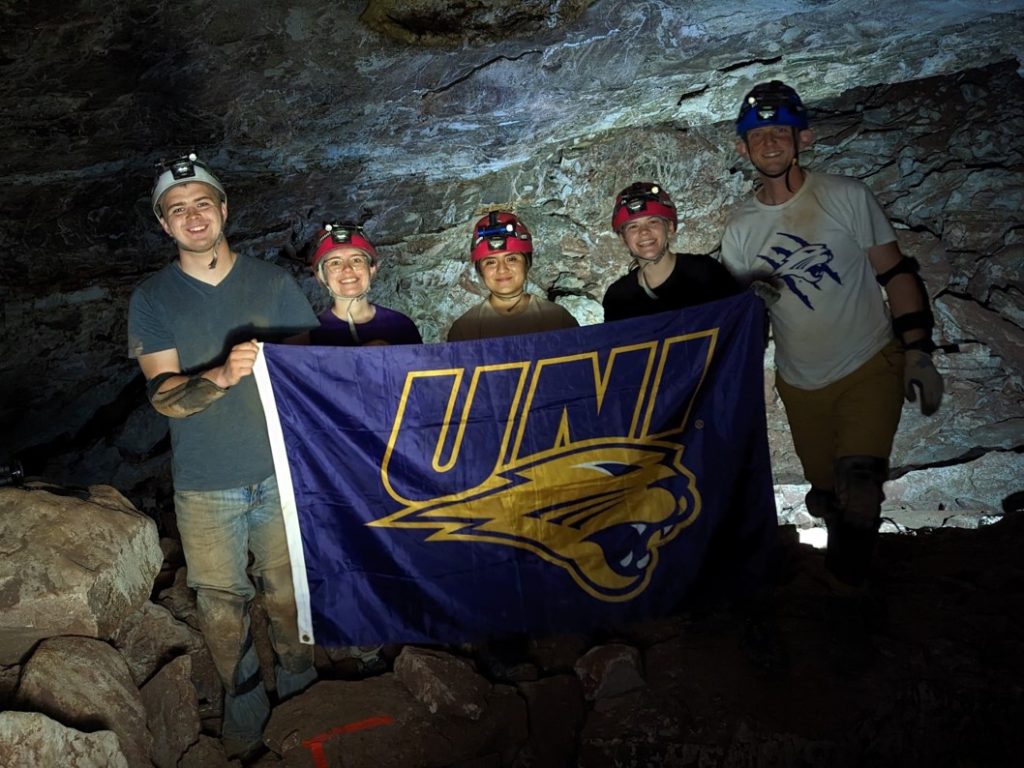
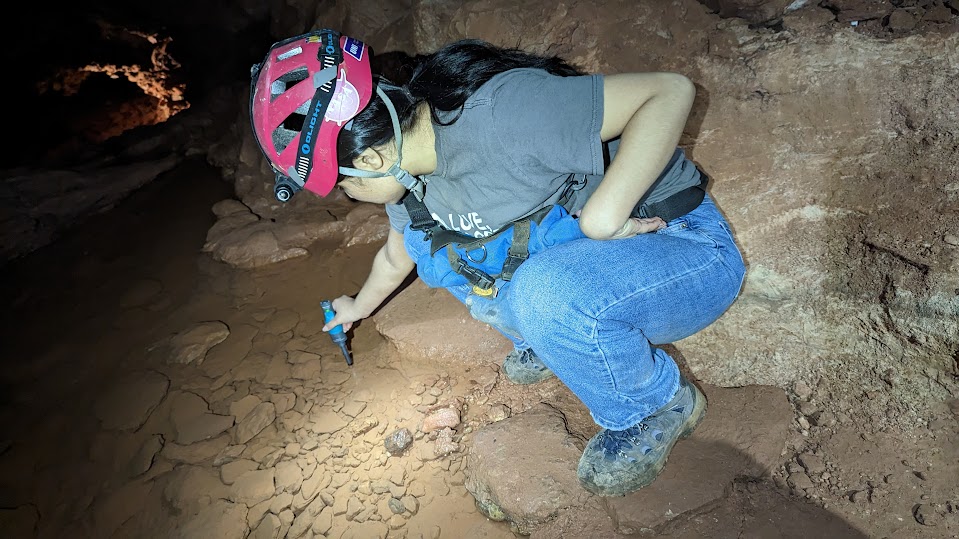

Spectroscopy Studies at Wind Cave: March 11-17
During Spring Break, the Astrobiology Underground group from the University of Northern Iowa spent 5 days working on several projects at Wind Cave National Park. Dr. Joshua Sebree and his team of undergrads worked with Marc Ohms at the park on several science missions: 1) Optimizing a shortwave-UV photography setup for taking images of cavern rooms to show mineral heterogeneity, 2) Updating and validating locations of Zebra Calcite in the Wind Cave inventory, 3) Collection of microbial samples on a gradient from the Natural Entrance to Calcite Lake.
Sunday, March 12: The first day at the cave was spent in the Candlelight tour route working on optimizing the shortwave UV-photography setup. This area of Wind Cave has large rooms with moonmilk in abundance. Under shortwave-UV, trace (<100 ppm) impurities in the calcite will fluoresce bright green. As moonmilk and other calcite formations generally appear white to the naked eye, the shortwave-UV photography highlights the non-uniformity in the formation, providing a deeper look at the formations without damaging them. A significant amount of time was spent on orientating the six shortwave-UV and camera exposure to create the right compositional picture. It was found that 3-4 minutes provided sufficient exposure time to photograph moonmilk 20-40 ft away.
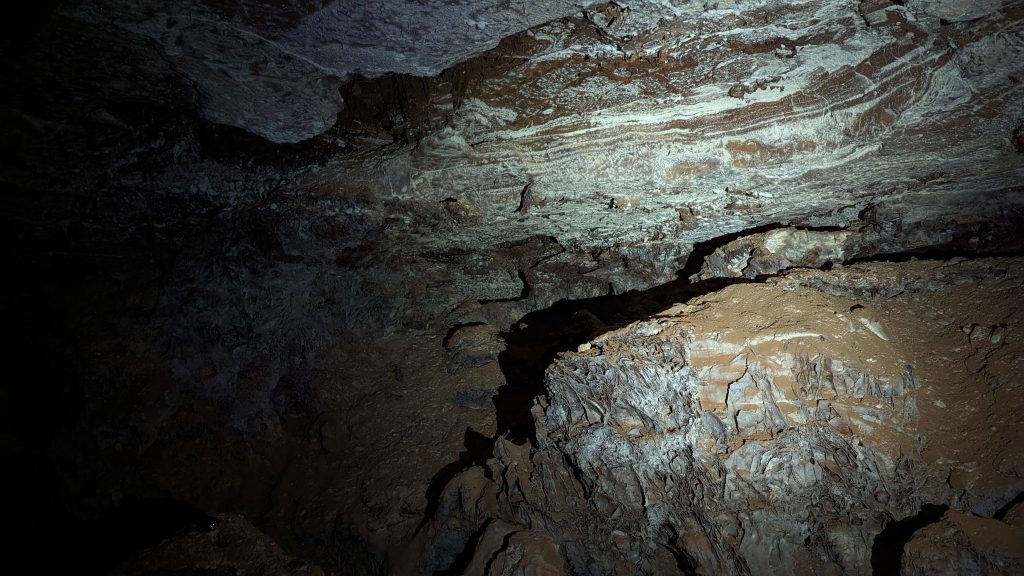
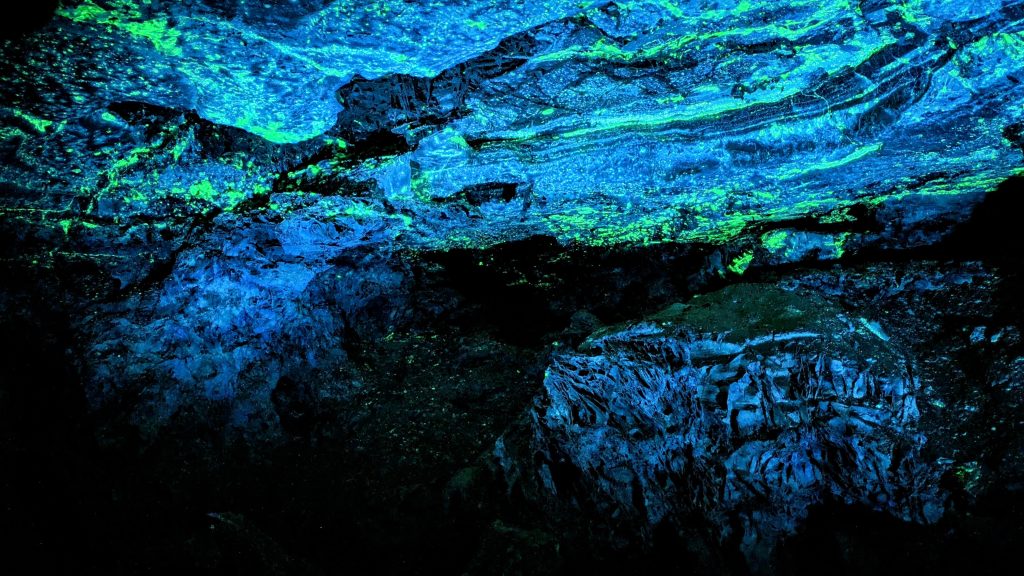
Monday, March 13: On day two, the team set a course for Christmas Tree Park to photograph the delicate aragonite structures with shortwave-UV photography. Along the way, several previously undocumented Zebra Calcites were discovered and noted down to study the next day. Reaching Christmas Tree Park in a little over an hour, the team had lunch and spent the next two hours taking shortwave-UV photographs of the area. This area of the cave is rich in moonmilk and aragonite frostwork but has an uneven spread of the impurities that are trapped in the calcite. While Christmas trees do not show the presence of impurities, both the moonmilk and some of the aragonite needles nearby do. After the photographs were finished, the team returned to the surface for a hearty meal and planned how to approach the Zebra Calcite work for day 3.
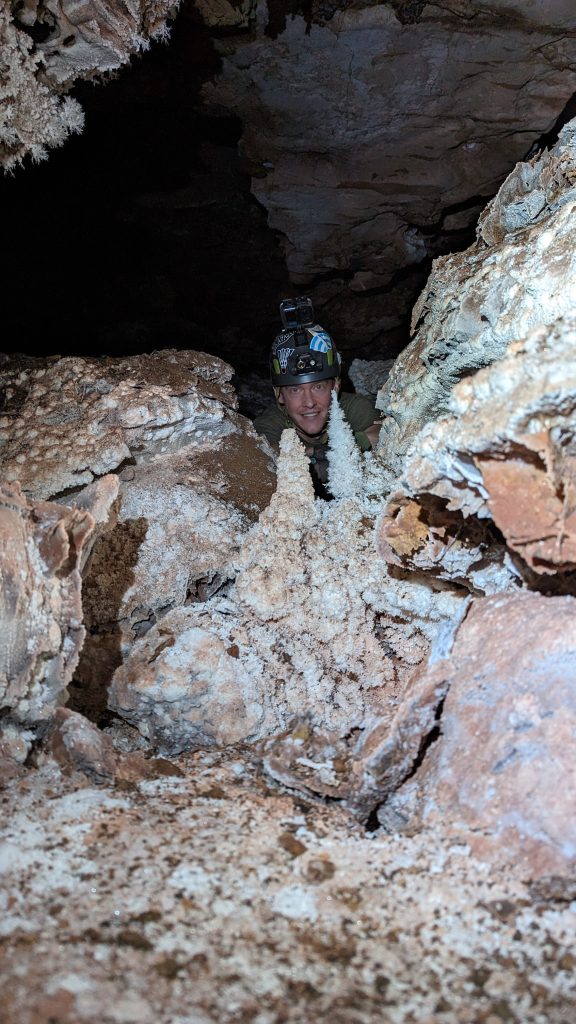
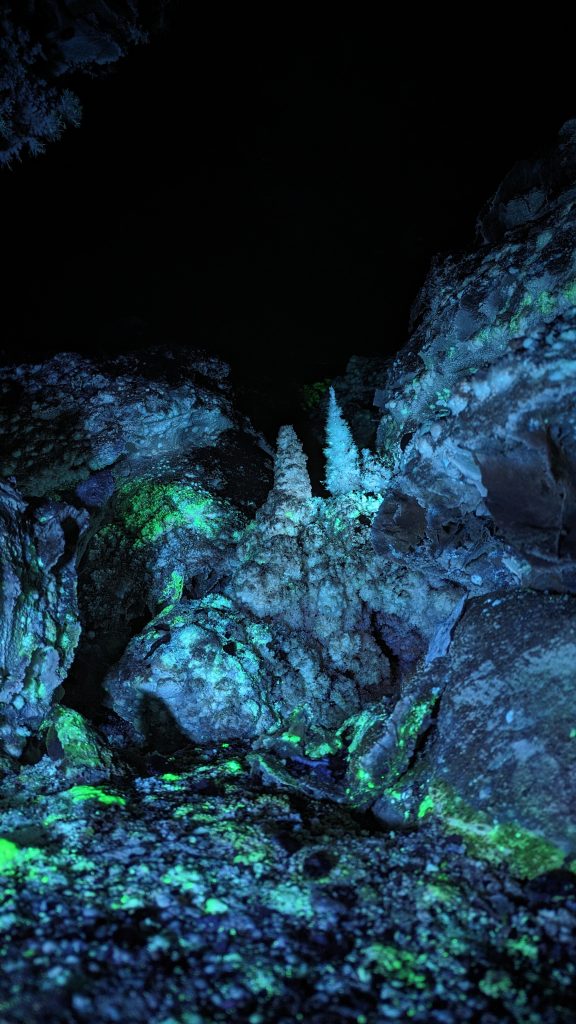

fluorescence in the very tips of the aragonite needles.
Tuesday. March 14: Day 3 of the trip was designated for finding/validating the location of Zebra Calcites in a small region of Wind Cave while also collecting water and microbial samples. Zebra Calcite at Wind Cave is composed of alternating bands of brown, tan, and white calcite crystals. The best example of this mineral at Wind Cave is the dome in Serengeti. As of December 2022, there were 6 known outcroppings of this mineral at Wind Cave. This particular mineral is of interest due to the high levels of Mn2+ present in the tan bands, indicating this feature was made in an aqueous environment. This Mn2+ also causes the mineral to fluoresce pink to purple depending on the concentration of Mn2+ trapped in the calcite. In addition, the six known Zebra Calcites were always found sandwiched at the interface of the paleo-fill of the upper cave and the box work containing limestone of the middle cave. It is hoped that a better understanding of the distribution of Zebra Calcites may enhance our understanding of Wind Cave’s formation. The Wind Cave inventory currently lists over 200 possible locations of “Zebra Rocks” of which some are sedimentary rocks and clays, while others are the Zebra Calcites of interest. Previous work during the Summer of 2022 resulted in 10 “rocks” being left as “rocks” and 2 reclassifications of “rocks” to “calcites.” With a potential new hypothesis for understanding where the calcite may be located, the team was able to add/confirm 12 Zebra Calcites in two different quadrants of the cave. Of particular interest were Zebra Calcites that was broken off in such a way that a gradient of fluorescence could be seen in the mineral under longwave-UV, representing a unique chance to study the influence of Mn2+ on the crystal properties. These specimens had previously gone unnoticed/classified as they were lacking the stripes as they did not cleave on a vertical plain.
In addition to the Zebra Calcites, many biological scrapings were taken through the upper layers of the cave.
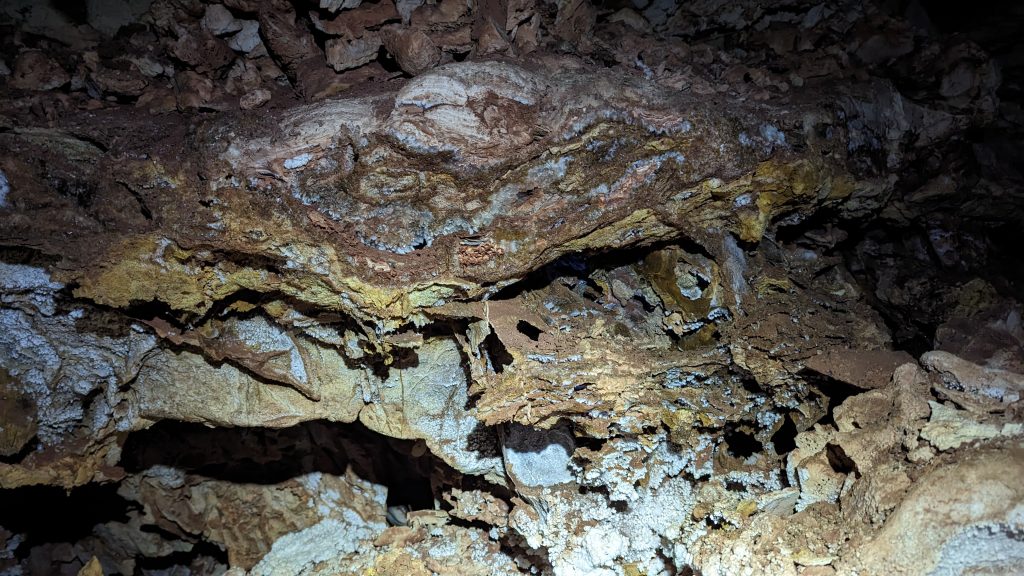
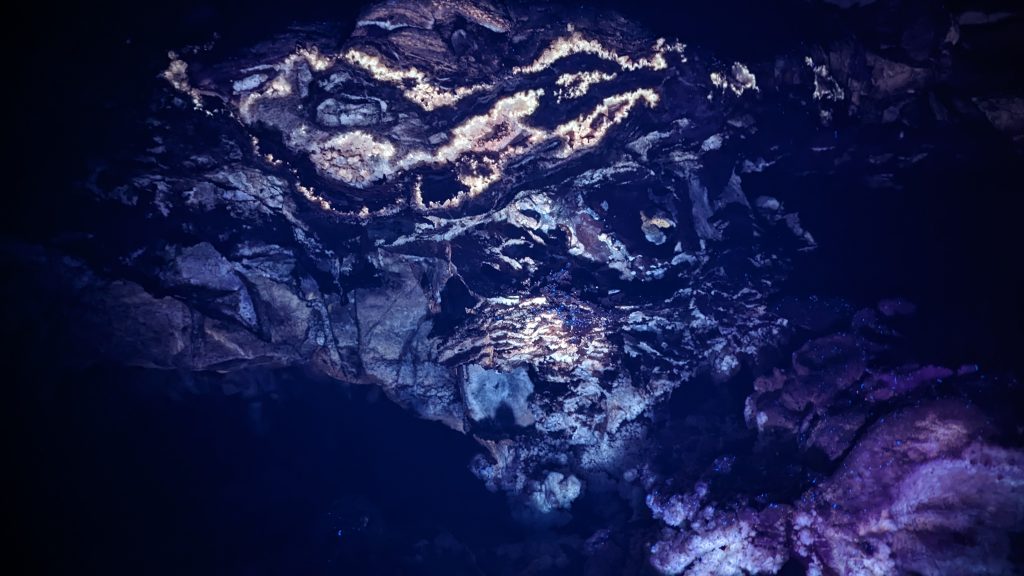
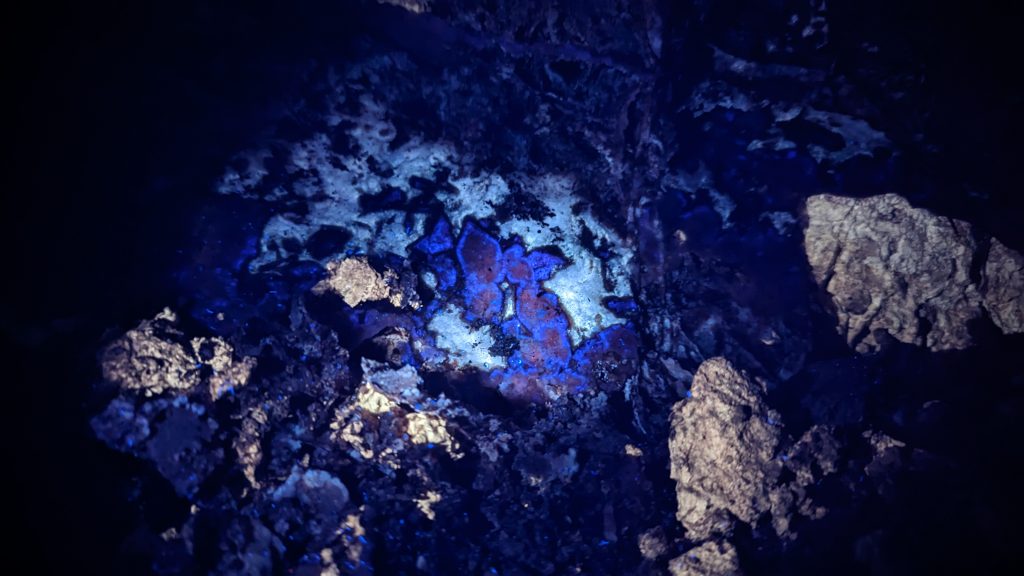
Wednesday, March 15: On day 4, the team made the several-kilometer trip to Calcite Lake and back. Two UNI students (Jenna and Lydia) accompanied Dr. Sebree and the park staff on the semiannual trip to the lake. While the park staff performed seasonal measurements of the lake, the science team took water quality measurements and scrapings for microbiological studies. Highlights of the day included visiting the lower sections of Wind Cave with its helictite bushes, a rope-assisted climb through Garden Gate, and threading the 8 in squeeze above What the Hell Lake.
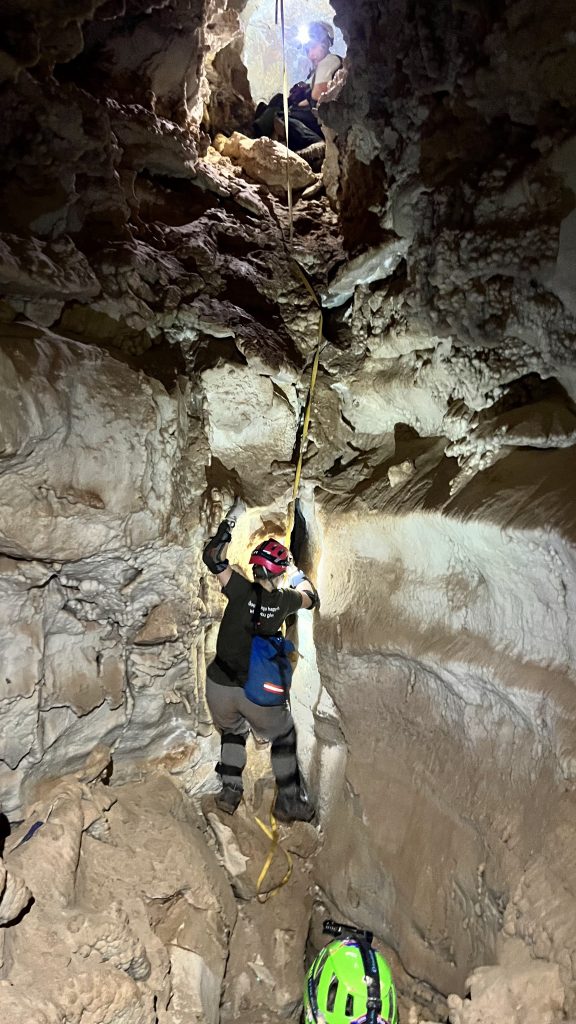
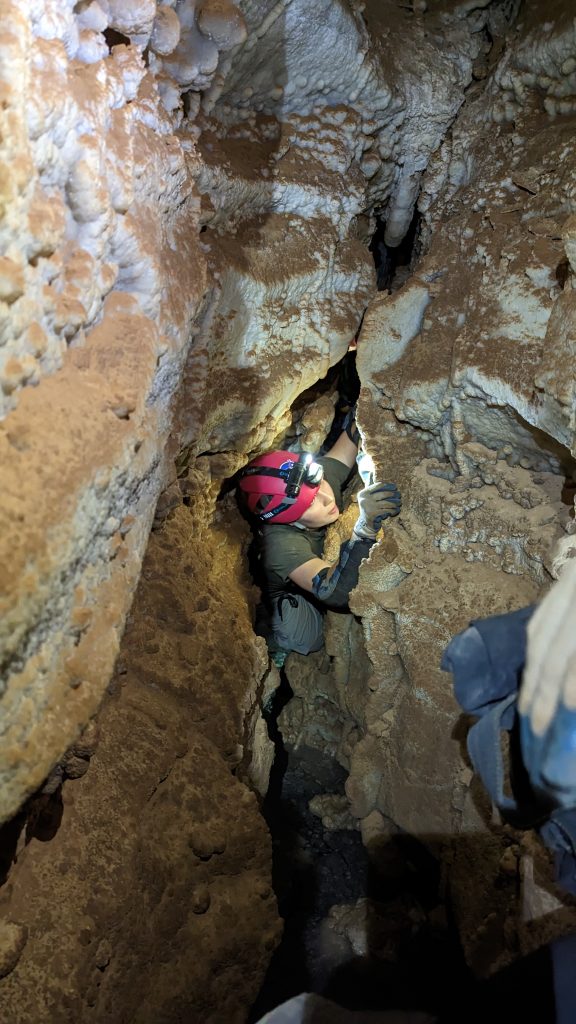
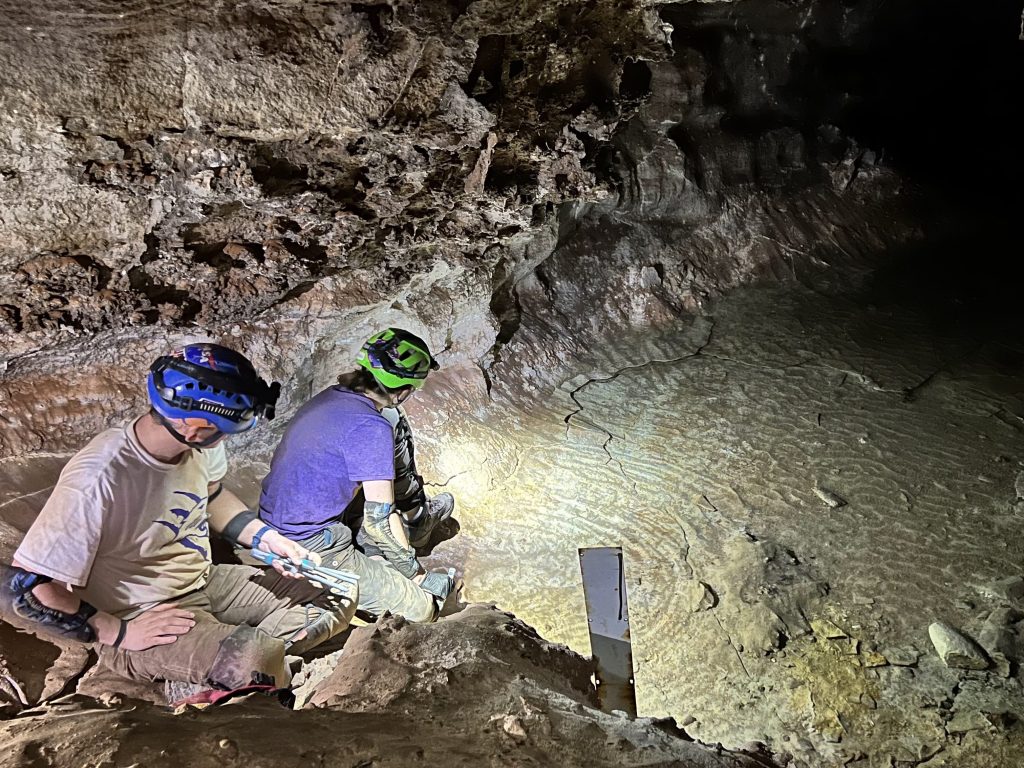
Thursday, March 16: The final day of the trip was set aside to help park staff and a film company tell the story of the cave for the new Wind Cave Museum exhibits. Despite being the shortest distance traveled during the week, it was the longest day in the cave. The science team and the film team spent 7 hours filming aspects of the research and parts of the cave. With the conclusion of the filming on the day, the UNI team’s time at Wind Cave was at an end and the team prepared for the long drive home on Friday.
